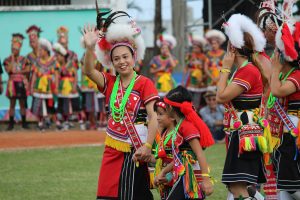When torrential rains triggered a massive flood along eastern Taiwan’s Fata’an Creek in late September, the surge of water formed a temporary barrier lake that later collapsed, inundating the nearby Pangcah/Amis Indigenous community, particularly the Fata’an tribal community. Homes, farmland, and roads were destroyed; several residents lost their lives, and thousands were displaced or forced to seek temporary shelter.
As the community begins to recover from the physical devastation, a deeper question has emerged: how can rebuilding ensure people’s safety while preserving the Indigenous identity, culture, and relationship to ancestral land that define Fata’an’s way of life?
As reconstruction begins, residents of Fata’an, one of the biggest Pangcah/Amis Indigenous communities in Taiwan, have voiced firm opposition to permanent relocation. Instead, they call for collective interim housing to be built on their ancestral land. This is an approach they describe as “moving away from danger, not away from home.” For the Pangcah/Amis Indigenous people, safety means more than physical protection; it includes the ability to remain connected to land, kinship, and ritual life.
For government planners, interim housing after a massive disaster is often framed as a technical question: how to move residents out of danger zones quickly and efficiently. But for Indigenous communities like the Fata’an, safety cannot be reduced to engineering and distance from risk. It also means cultural safety: the ability to stay connected to land, kin, and daily practices that sustain emotional and spiritual well-being.
The principle of cultural safety, first developed in Indigenous health frameworks, means that institutions must avoid practices that undermine Indigenous values and self-determination. Applied to disaster recovery, it calls for rebuilding efforts that protect social and cultural systems, not just infrastructure.
Interim housing, if designed with cultural safety in mind, can serve as more than a temporary shelter. It can become a space for healing, restoring social bonds, and rebuilding confidence in both the land and the future.
For Taiwan’s Indigenous peoples, natural disasters have long carried a slower cultural cost. After previous forced relocations in the past years, Indigenous residents experienced isolation, depression, and even suicide, as life in unfamiliar reinforced concrete apartment complexes settlements disrupted communal rhythms and eroded meaning.
After Typhoon Morakot in 2009, for example, Indigenous villages were permanently relocated into standardized housing away from their lands. The result was social fragmentation, loss of traditional livelihoods, and a deep sense of alienation.
That experience now shapes Fata’an’s determination to avoid another wave of cultural displacement.
Unlike past relocation programs, the community’s proposal for interim housing is not just technical. It is cultural. Temporary yet grounded in Pangcah/Amis social design, interim housing would allow families to stay together, maintain ritual life, and gradually rebuild while monitoring environmental changes. In this sense, “interim housing” becomes a bridge between survival and continuity.
Fata’an’s leaders argue that current top-down plans risk repeating old mistakes. Local governments, focused on engineering and budget efficiency, have yet to guarantee Indigenous participation in decision-making. But a participatory approach – inviting elders, youth, community leaders, and cultural experts into planning – could transform recovery into empowerment.
In policy language, resilience often refers to infrastructure. For Indigenous communities, resilience is relational. It resides in continuity of place, language, kinship, well-being, and so much more. Well-designed interim housing can serve as a foundation for that continuity, offering time to heal and space to deliberate on long-term relocation, if necessary.
Taiwan’s experience at Fata’an adds another voice: rebuilding should not mean starting over, but starting again together.
The Fata’an flood has exposed both the fragility of Taiwan’s disaster governance and weaknesses in its approach to Indigenous peoples. True recovery will require weaving together both physical and cultural forms of safety. If transitional housing becomes a platform for community participation and cultural sovereignty, it could set a precedent for more comprehensive disaster policy in Taiwan and beyond.
Disasters demand speed, but recovery demands reflection. For the Fata’an, healing will not come from relocation alone; it must be rooted in both land and culture.




























